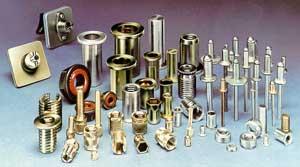Process Encyclopaedia
Mechanical fastening
Other names / variants: rivets, snap-fits, screws, bolts, nuts
Related processes in this database include:
Joining (generic)
Overview
Mechanical joining falls into two distinct groups: fasteners and integral joints. Examples of fasteners include: nuts and bolts, screws, pins and rivets; examples of integral joints include: seams, crimps, snap-fits and shrink-fits.
Some form of mechanical joining needs to be used where products need to be taken apart during their normal life, e.g. where repair or maintenance is likely.
With the move towards efficient recycling, there is likely to be increased use of mechanical fastening.

Materials and shapes
- Virtually any material in any shape can be joined by mechanical fastening - given enough ingenuity!
- Practical limitations come from being able to form holes - this limits the options for ceramics and composites. Snap-fit joints are especially suitable for low stiffness materials like polymers.
- Especially good for joining different materials (e.g. composite to metal).
- Joint quality is reliable and readily determined, given sufficient operator skill. However, mechanical joining usually reduces fatigue life.
- Essential where two parts will move relative to each other (e.g. hinges for doors).
- The non-permanence of many fasteners is useful for products that may need repair/maintenance or need access to the interior.
Economics
- Can be economic for any batch size from one-offs to mass production (with or without automation).
- Ease of mechanical joining (especially with snap fits) means low skilled workers can be used.
- For fasteners, there can be a significant stock cost in ordering and keeping track of so many components!
- By far the dominant means of joining parts.
- Competes with welding for thick metallic sections where a permanent joint is needed.
- Competes with adhesives for polymers and woods where a permanent joint is needed.

